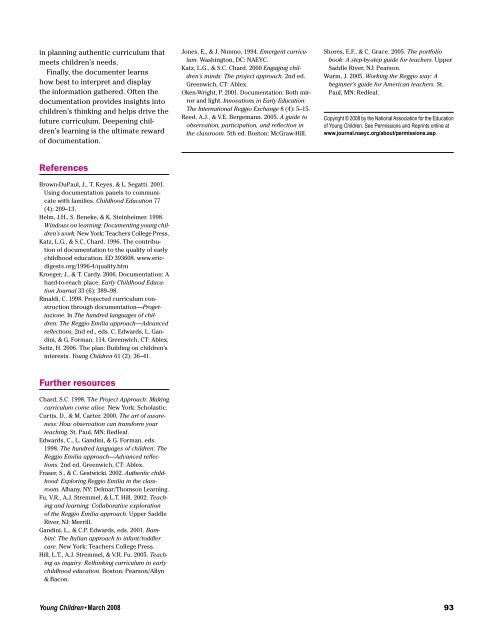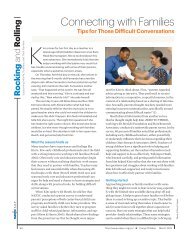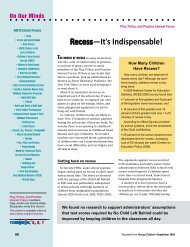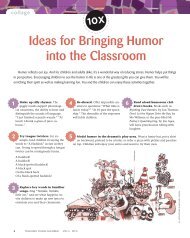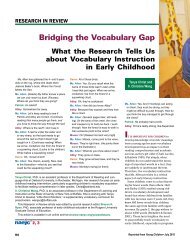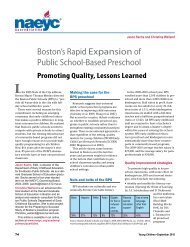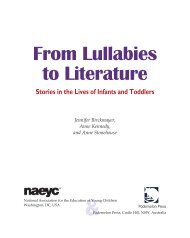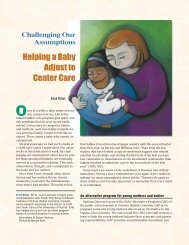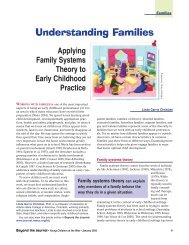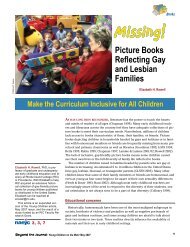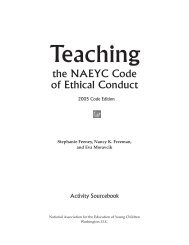The Power of Documentation - National Association for the ...
The Power of Documentation - National Association for the ...
The Power of Documentation - National Association for the ...
You also want an ePaper? Increase the reach of your titles
YUMPU automatically turns print PDFs into web optimized ePapers that Google loves.
in planning au<strong>the</strong>ntic curriculum that<br />
meets children’s needs.<br />
Finally, <strong>the</strong> documenter learns<br />
how best to interpret and display<br />
<strong>the</strong> in<strong>for</strong>mation ga<strong>the</strong>red. Often <strong>the</strong><br />
documentation provides insights into<br />
children’s thinking and helps drive <strong>the</strong><br />
future curriculum. Deepening children’s<br />
learning is <strong>the</strong> ultimate reward<br />
<strong>of</strong> documentation.<br />
References<br />
Brown-DuPaul, J., T. Keyes, & L. Segatti. 2001.<br />
Using documentation panels to communicate<br />
with families. Childhood Education 77<br />
(4): 209–13.<br />
Helm, J.H., S. Beneke, & K. Steinheimer. 1998.<br />
Windows on learning: Documenting young children’s<br />
work. New York: Teachers College Press.<br />
Katz, L.G., & S.C. Chard. 1996. <strong>The</strong> contribution<br />
<strong>of</strong> documentation to <strong>the</strong> quality <strong>of</strong> early<br />
childhood education. ED 393608. www.ericdigests.org/1996-4/quality.htm<br />
Kroeger, J., & T. Cardy. 2006. <strong>Documentation</strong>: A<br />
hard-to-reach place. Early Childhood Education<br />
Journal 33 (6): 389–98.<br />
Rinaldi, C. 1998. Projected curriculum construction<br />
through documentation—Progettazione.<br />
In <strong>The</strong> hundred languages <strong>of</strong> children:<br />
<strong>The</strong> Reggio Emilia approach—Advanced<br />
reflections, 2nd ed., eds. C. Edwards, L. Gandini,<br />
& G. Forman, 114. Greenwich, CT: Ablex.<br />
Seitz, H. 2006. <strong>The</strong> plan: Building on children’s<br />
interests. Young Children 61 (2): 36–41.<br />
Fur<strong>the</strong>r resources<br />
Chard, S.C. 1998. <strong>The</strong> Project Approach: Making<br />
curriculum come alive. New York: Scholastic.<br />
Curtis, D., & M. Carter. 2000. <strong>The</strong> art <strong>of</strong> awareness:<br />
How observation can trans<strong>for</strong>m your<br />
teaching. St. Paul, MN: Redleaf.<br />
Edwards, C., L. Gandini, & G. Forman, eds.<br />
1998. <strong>The</strong> hundred languages <strong>of</strong> children: <strong>The</strong><br />
Reggio Emilia approach—Advanced reflections.<br />
2nd ed. Greenwich, CT: Ablex.<br />
Fraser, S., & C. Gestwicki. 2002. Au<strong>the</strong>ntic childhood:<br />
Exploring Reggio Emilia in <strong>the</strong> classroom.<br />
Albany, NY: Delmar/Thomson Learning.<br />
Fu, V.R., A.J. Stremmel, & L.T. Hill. 2002. Teaching<br />
and learning: Collaborative exploration<br />
<strong>of</strong> <strong>the</strong> Reggio Emilia approach. Upper Saddle<br />
River, NJ: Merrill.<br />
Gandini, L., & C.P. Edwards, eds. 2001. Bambini:<br />
<strong>The</strong> Italian approach to infant/toddler<br />
care. New York: Teachers College Press.<br />
Hill, L.T., A.J. Stremmel, & V.R. Fu. 2005. Teaching<br />
as inquiry: Rethinking curriculum in early<br />
childhood education. Boston: Pearson/Allyn<br />
& Bacon.<br />
Jones, E., & J. Nimmo. 1994. Emergent curriculum.<br />
Washington, DC: NAEYC.<br />
Katz, L.G., & S.C. Chard. 2000 Engaging children’s<br />
minds: <strong>The</strong> project approach. 2nd ed.<br />
Greenwich, CT: Ablex.<br />
Oken-Wright, P. 2001. <strong>Documentation</strong>: Both mirror<br />
and light. Innovations in Early Education:<br />
<strong>The</strong> International Reggio Exchange 8 (4): 5–15.<br />
Reed, A.J., & V.E. Bergemann. 2005. A guide to<br />
observation, participation, and reflection in<br />
<strong>the</strong> classroom. 5th ed. Boston: McGraw-Hill.<br />
Shores, E.F., & C. Grace. 2005. <strong>The</strong> portfolio<br />
book: A step-by-step guide <strong>for</strong> teachers. Upper<br />
Saddle River, NJ: Pearson.<br />
Wurm, J. 2005. Working <strong>the</strong> Reggio way: A<br />
beginner’s guide <strong>for</strong> American teachers. St.<br />
Paul, MN: Redleaf.<br />
Copyright © 2008 by <strong>the</strong> <strong>National</strong> <strong>Association</strong> <strong>for</strong> <strong>the</strong> Education<br />
<strong>of</strong> Young Children. See Permissions and Reprints online at<br />
www.journal.naeyc.org/about/permissions.asp.<br />
Young Children • March 2008 93


